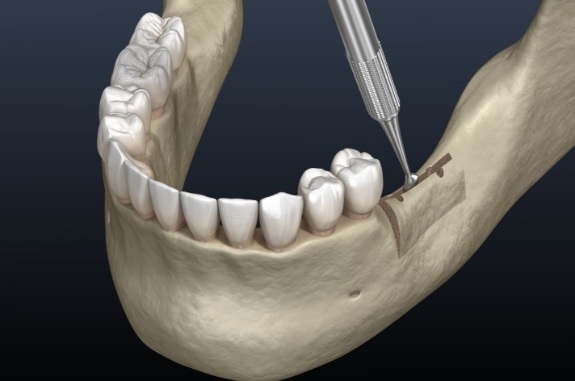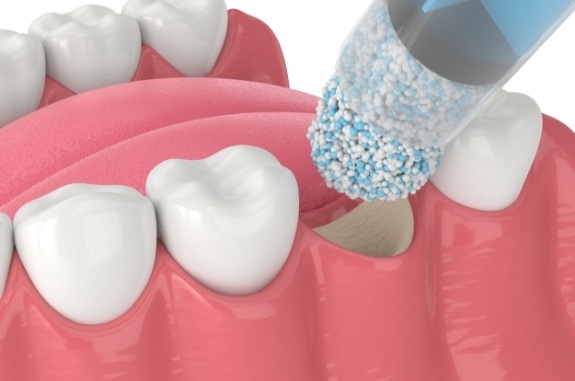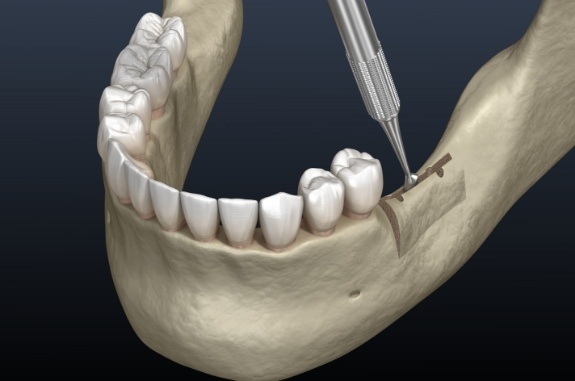Dental Ridge Preservation – Clute, TX
Keeping Your Jaw Healthy for Dental Implants
Ridge preservation or ridge augmentation is a procedure in which the dentist uses a bone replacement graft for ridge preservation. When you lose your teeth, or when you have to get dental extraction done because of some dental disease, there’s a small, unprotected ridge or socket left behind. Over time, due to the missing tooth, this ridge becomes sensitive, and you also lose bone structure in the location of the missing tooth. Ridge preservation uses bone grafting material to prevent bone loss and to protect the ridge. Call us to learn more about dental ridge preservation in Clute.
Why Choose Woodshore Family Dentistry for Dental Ridge Preservation?
- Specialty Dental Procedures Performed In-House
- Friendly, Helpful Dental Staff Members
- Variety of Convenient Dental Financing Options
What Is Dental Ridge Augmentation?

Ridge augmentation is a procedure in which the dentist uses grafting material that’s taken from external sources (animal parts, other humans, the individual’s body, or synthetic materials) to protect the empty socket of the missing tooth and prevent bone loss. That’s why this procedure is also known as dental socket preservation.
Is Bone Grafting Necessary After a Tooth Extraction?

A bone graft is not necessary after tooth extraction. In fact, many people don’t get ridge preservation after tooth extraction. But it’s still extremely beneficial and highly recommended.
There are several reasons why you may need bone graft ridge preservation after tooth extraction:
- Dry Socket: Dry socket is a condition in which the empty socket left after the tooth extraction becomes extremely sensitive. This is because the socket is only protected by a blood clot after the extraction. When the blood clot comes undone, it can expose the nerves lying underneath the socket, which makes you extremely sensitive to external environmental conditions. This is a dry socket, and it can be extremely painful.
- Bone Preservation: The root of your tooth is surrounded by a bone known as the alveolar ridge. This bone isn’t necessary, but it’s important if you want to get dental implants later because the metallic post will have to be inserted into the ridge to support the dental crown or bridge. However, when you lose your teeth, this bone gradually starts eroding, and it gets to such a point that you don’t have sufficient bone structure for the dental implants. With ridge augmentation, you can ensure that your bone structure remains intact even if you’re missing a tooth. As such, you’ll have the option to get dental implants later if you’re interested.
- Aesthetic Preservation: When you lose one of your teeth, the surrounding teeth start drifting away and get misaligned, which can ruin the cosmetic appearance. Ridge preservation and dental implants can keep your teeth in place and enhance your cosmetic appearance.
Dental Ridge Augmentation Procedure

Your bone continues growing because of chewing movements provided by the tooth. So, when you lose your tooth, your bone stops growing and starts degenerating. In a single year, you can lose about 25% of your bone structure. That’s why the ridge augmentation procedure is done as soon as tooth extraction is complete so your bone can be preserved.
The following are the primary steps involved in the ridge preservation procedure:
- After examining the ridge and the empty socket, the dentist will discuss your grafting material options. You can go for a grafting material from another part of your body, from another individual, from an animal part, or synthetic materials. The dentist will discuss them with you in detail.
- The dentist will create an incision on your exposed socket and place the grafting material along with the underlying ridge. They’ll also cover it with collagen to facilitate healing.
- Finally, the dentist will suture the incision so that your wound can heal. The grafting material will ensure that there’s no bone loss.
What Happens to an Exposed Socket After Tooth Extraction?

After the tooth extraction procedure, you need to be careful with your exposed socket. The following tips will help you take care of them:
- Avoid brushing your teeth for a day or two after the tooth extraction, as it may lead to a dry socket by removing the blood clot.
- Avoid cigarettes and drinking from straws for a few days.
- Only consume soft food items because hard ones can remove the blood clot.
What Are the Advantages of Dental Bone Grafting?

The following are some of the main advantages of bone grafting:
- If you get a bone graft immediately after removing your teeth, you can preserve the alveolar ridge and prevent bone loss.
- If you’ve already suffered from bone loss, then a bone grafting procedure can help with bone regeneration.
- Bone grafting allows you to preserve or restore your bone structure, which, in turn, allows you to get dental implants, which are the best replacement for missing teeth.
I Need a Checkup & Cleaning I Need a Dentist for My Child I am Worried About Gum Disease I Have a Cavity or Broken Tooth I am Missing One or More Teeth I Want to Enhance My Smile I Want a Straighter Smile I am Concerned About Sleep Apnea I am Scared of the Dentist I Have Pain in My Jaw I Have a Dental Emergency View Our Services


